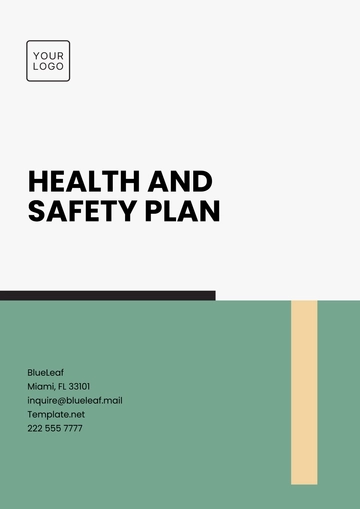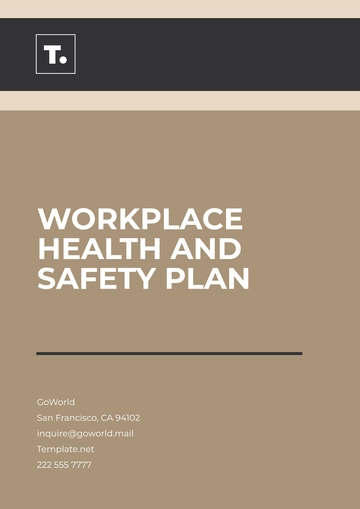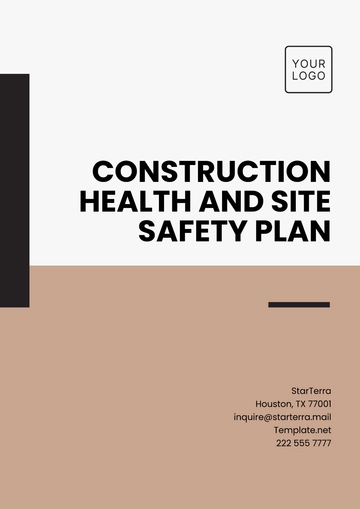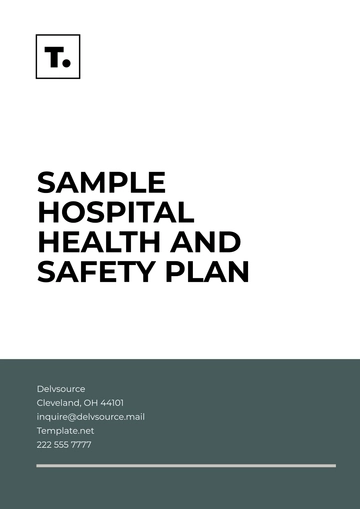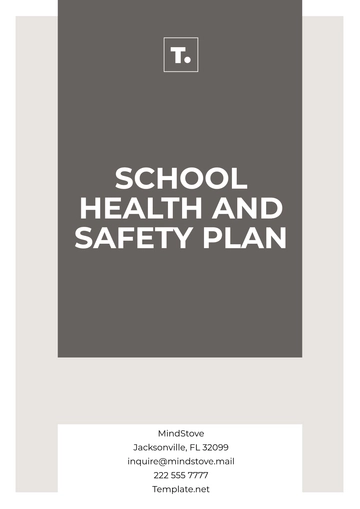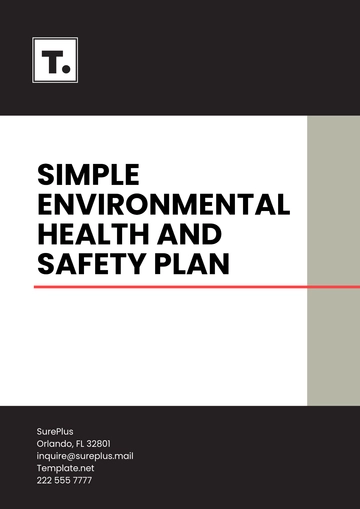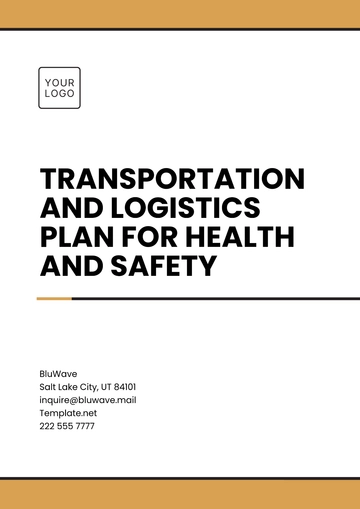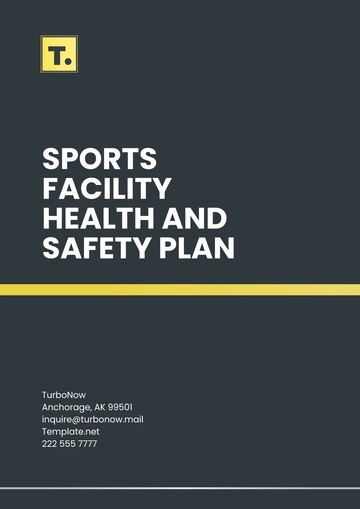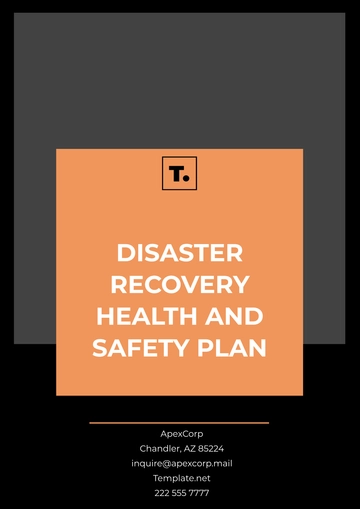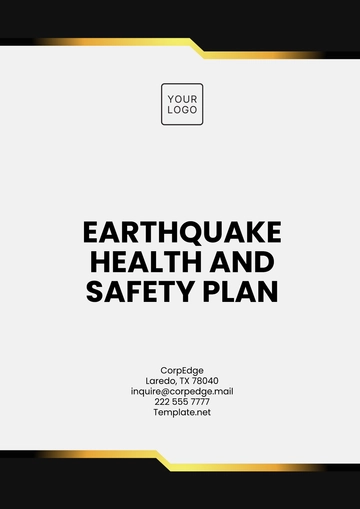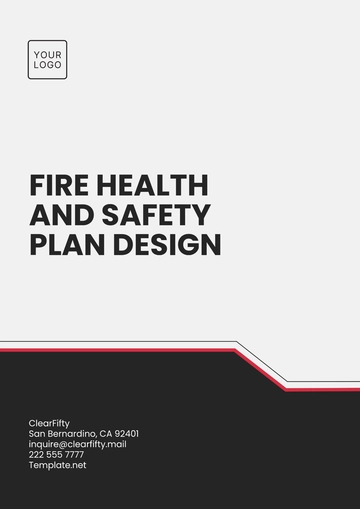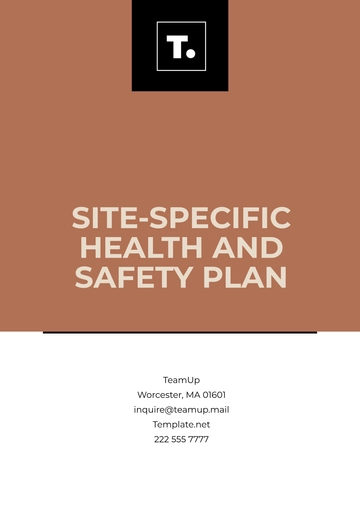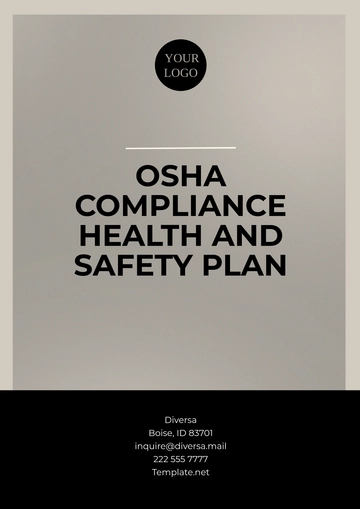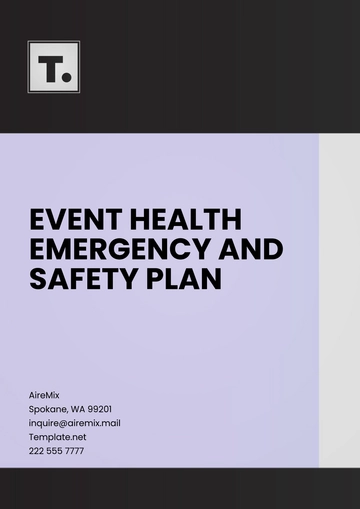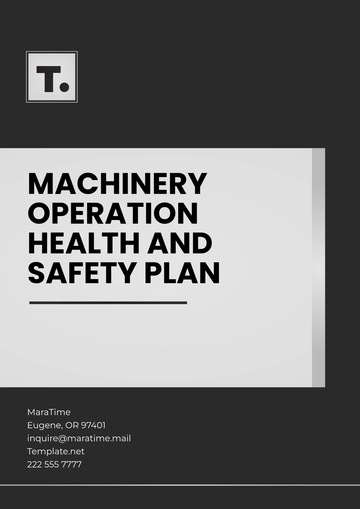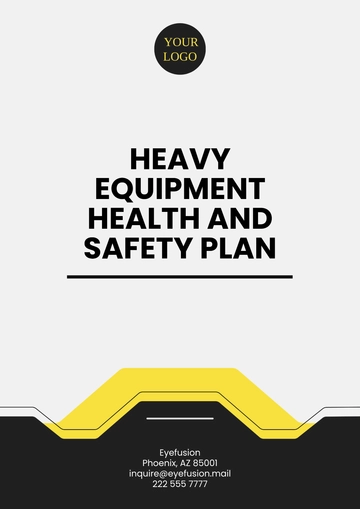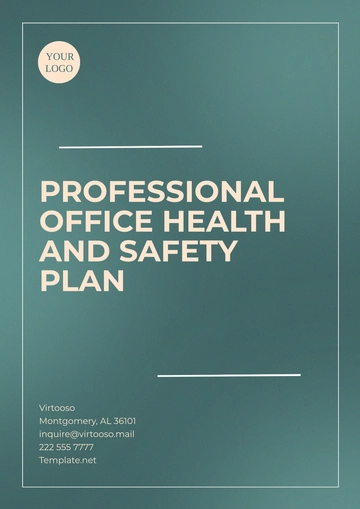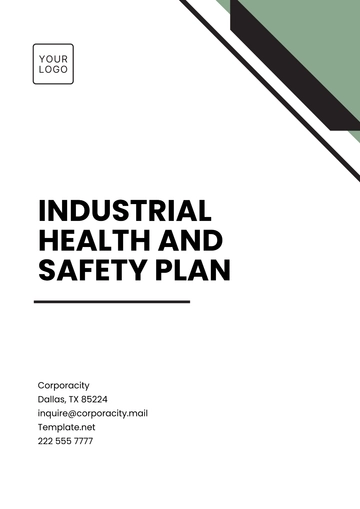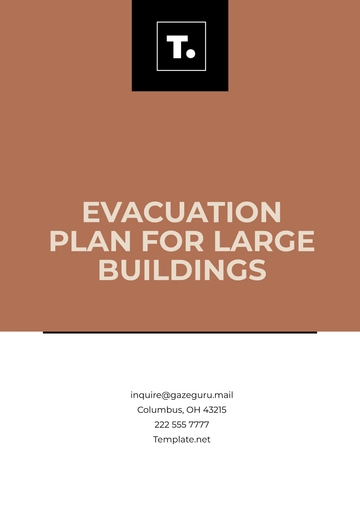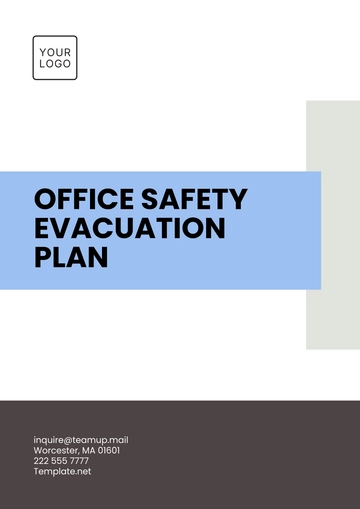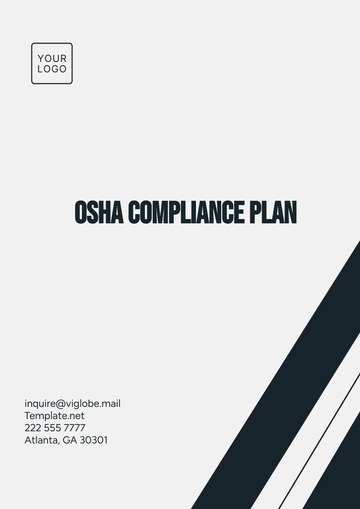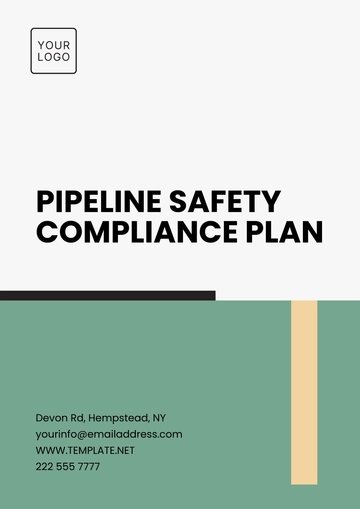Free Restaurant Safety Plan

I. Introduction
1. Purpose of the Safety Plan
The purpose of this Safety Plan is to ensure a safe and healthy environment for employees, customers, and visitors at [Your Company Name]. This plan outlines the policies, procedures, and practices necessary to prevent accidents, injuries, and illnesses in the workplace. By adhering to this plan, [Your Company Name] aims to comply with all relevant safety regulations and foster a culture of safety within the organization.
2. Scope and Applicability
This Safety Plan applies to all employees, contractors, and visitors at [Your Company Name]. It covers all aspects of restaurant operations, including food preparation, service, cleaning, and maintenance. The plan is designed to address the specific risks and hazards associated with the restaurant industry, ensuring comprehensive safety measures are in place.
3. Goals and Objectives
The primary goals and objectives of this Safety Plan are:
To prevent workplace accidents and injuries
To promote a safe and healthy work environment
To ensure compliance with legal and regulatory safety requirements
To provide employees with the knowledge and resources necessary to work safely
To foster a culture of safety and responsibility within the organization
4. Responsibility and Accountability
Safety is a shared responsibility at [Your Company Name]. All employees are expected to adhere to the safety policies and procedures outlined in this plan. Specific responsibilities include:
Management: Develops, implements, and enforces safety policies; provides training and resources; conducts regular safety audits.
Supervisors: Ensures employees follow safety procedures; conducts safety briefings; reports and investigates incidents.
Employees: Complies with safety policies; uses personal protective equipment; reports hazards and incidents.
Safety Committee: Reviews and updates the Safety Plan; monitors safety performance; addresses safety concerns.
II. Safety Policies and Procedures
1. General Safety Rules
Always follow posted safety signs and instructions.
Report any unsafe conditions or practices to a supervisor immediately.
Use personal protective equipment (PPE) as required.
Do not engage in horseplay or unsafe behavior.
Keep work areas clean and organized to prevent accidents.
2. Personal Protective Equipment (PPE)
Personal protective equipment is essential for preventing injuries in the workplace. The following table outlines the types of PPE required for various tasks at [Your Company Name]:
Task | Required PPE |
|---|---|
Food Preparation | Hairnet, Gloves |
Cleaning | Gloves, Apron, Goggles |
Handling Hot Surfaces | Oven Mitts, Apron |
Working with Knives | Cut-Resistant Gloves |
Waste Disposal | Gloves, Closed-Toe Shoes |
3. Safe Work Practices
Always use proper lifting techniques to avoid back injuries. Bend your knees and keep your back straight.
Use tools and equipment according to manufacturer instructions.
Do not attempt to repair or operate malfunctioning equipment. Report it to a supervisor.
Use ladders and step stools safely. Ensure they are stable and secure before use.
Avoid distractions and focus on the task at hand, especially when handling sharp objects or hot surfaces.
4. Emergency Procedures
a. Fire Safety
Know the location of fire extinguishers and how to use them.
In case of fire, alert others and evacuate the building immediately.
Do not use elevators during a fire evacuation.
Assemble at the designated meeting point outside the building.
b. Medical Emergencies
Call 911 immediately for any serious injuries or medical emergencies.
Provide first aid if trained and necessary.
Report all incidents to a supervisor as soon as possible.
c. Natural Disasters
Follow instructions from management and local authorities.
Move to designated safe areas within the building.
Do not leave the premises until it is safe to do so.
d. Evacuation Plan
Familiarize yourself with all exit routes and emergency exits.
Participate in regular evacuation drills.
Assist customers and colleagues in evacuating the building safely.
5. Hazard Communication
a. Material Safety Data Sheets (MSDS)
MSDS for all hazardous materials used in the restaurant are kept in a designated binder accessible to all employees.
Employees must review MSDS before using any chemicals and follow the recommended safety precautions.
b. Labeling and Signage
All containers of hazardous materials must be clearly labeled with the contents and hazard warnings.
Safety signs, including exit signs, fire extinguisher locations, and hazard warnings, must be prominently displayed and maintained.
III. Health and Sanitation
1. Food Handling and Storage
Proper food handling and storage are crucial for preventing foodborne illnesses. The following practices must be adhered to:
Task | Procedure |
|---|---|
Receiving Deliveries | Inspect for damage, ensure proper temperatures |
Storing Food | Label and date all items, store at correct temperatures |
Preparing Food | Wash hands and surfaces, avoid cross-contamination |
Serving Food | Maintain hot foods at 140°F or above, cold foods at 40°F or below |
2. Hygiene Standards
Employees must wash their hands thoroughly with soap and water before and after handling food, after using the restroom, and after any activity that could contaminate their hands.
Employees must wear clean uniforms and hairnets or hats to prevent contamination.
Fingernails must be kept short and clean. No false nails or nail polish are allowed.
3. Cleaning and Sanitization
All surfaces, utensils, and equipment must be cleaned and sanitized regularly according to the cleaning schedule.
High-touch areas such as door handles, countertops, and restrooms must be cleaned frequently throughout the day.
Use approved sanitizing solutions and follow the manufacturer's instructions for dilution and contact time.
4. Pest Control
Regularly inspect the premises for signs of pests.
Keep food storage areas clean and organized to prevent pest infestations.
Seal all cracks and openings where pests could enter.
Work with a licensed pest control service for regular inspections and treatments.
5. Waste Management
Separate waste into appropriate containers for recycling, composting, and landfill.
Empty waste containers regularly to prevent overflow and odors.
Ensure waste storage areas are clean and secure to prevent pest access.
IV. Employee Training and Education
1. Orientation and Onboarding
New employees must receive a safety orientation that covers the restaurant's safety policies, emergency procedures, and PPE requirements.
Orientation includes a walkthrough of the premises to familiarize new hires with safety equipment and emergency exits.
2. Regular Safety Training
All employees must participate in regular safety training sessions, covering topics such as fire safety, first aid, and safe work practices.
Training sessions are conducted at least quarterly and documented for compliance.
3. Certification and Compliance
Employees handling food must obtain food handler certification as required by local regulations.
Training for specific tasks, such as operating kitchen equipment or handling hazardous materials, must be completed and certified.
4. Safety Drills and Exercises
Regular safety drills, including fire drills and evacuation exercises, must be conducted to ensure all employees know how to respond to an emergency.
Drills are evaluated, and feedback is provided to improve performance.
V. Equipment and Facility Safety
1. Maintenance and Inspections
Regular maintenance and inspections are crucial for ensuring that all equipment and facilities remain in safe working condition. At [Your Company Name], we have established a rigorous maintenance schedule to prevent accidents and equipment failures.
Daily Inspections: Employees are required to conduct daily visual inspections of all kitchen equipment, including stoves, ovens, refrigerators, and dishwashers. Any signs of wear or malfunction must be reported immediately.
Weekly Inspections: A designated maintenance team conducts more thorough inspections weekly, checking for issues that may not be apparent in daily checks.
Monthly Inspections: Comprehensive inspections by certified technicians are conducted monthly. These inspections include checking electrical systems, ventilation, and structural integrity of the facility.
Inspection Type | Frequency | Responsible Party | Checklist Items |
|---|---|---|---|
Daily | Daily | All Kitchen Staff | Visual checks for leaks, malfunctions, cleanliness |
Weekly | Weekly | Maintenance Team | Detailed equipment checks, minor repairs |
Monthly | Monthly | Certified Technicians | Electrical systems, ventilation, and major equipment checks |
2. Safe Use of Kitchen Equipment
Proper use of kitchen equipment is essential to maintaining a safe working environment. All employees at [Your Company Name] receive comprehensive training on the correct use and handling of kitchen equipment.
Training: Employees are trained in the operation of stoves, ovens, mixers, slicers, and other kitchen equipment. Training includes reading manufacturer manuals and hands-on practice.
Safety Precautions: Always unplug equipment before cleaning. Use cut-resistant gloves when handling sharp objects. Follow proper lifting techniques to avoid back injuries.
Equipment | Training Requirements | Safety Precautions |
|---|---|---|
Stoves & Ovens | Manufacturer manual, hands-on practice | Keep flammable items away, check for gas leaks |
Mixers & Slicers | Safety operation training | Use cut-resistant gloves, unplug them before cleaning |
Refrigerators | Temperature monitoring training | Ensure door seals are intact, report leaks |
3. Electrical Safety
Electrical safety is a priority at [Your Company Name] to prevent fires and injuries. Regular inspections and adherence to safety protocols are mandatory.
Inspection: Electrical outlets and equipment are inspected regularly to ensure they are in good condition and free of hazards.
Usage: Avoid overloading outlets. Extension cords should not be used as a permanent solution and must be kept away from water sources.
Emergency Protocols: In case of an electrical fire, use only a Class C fire extinguisher. Ensure all employees know the location of electrical shut-offs.
Safety Measure | Frequency | Responsible Party | Notes |
|---|---|---|---|
Electrical Inspections | Monthly | Certified Electrician | Check for frayed wires, secure connections |
Equipment Checks | Before use | All Employees | Ensure equipment is dry and undamaged |
Emergency Drills | Quarterly | Safety Coordinator | Practice the use of fire extinguishers |
4. Ventilation and Air Quality
Maintaining proper ventilation and air quality is essential for a safe and comfortable working environment. [Your Company Name] implements strict measures to ensure optimal air quality.
Ventilation System: The ventilation system is inspected and cleaned regularly to ensure it is functioning correctly.
Air Filters: Grease filters in hoods and exhaust systems are cleaned and replaced as necessary to prevent buildup.
Air Quality Monitoring: Air quality is monitored to ensure compliance with health and safety standards.
Task | Frequency | Responsible Party | Notes |
|---|---|---|---|
Ventilation Inspection | Monthly | Maintenance Team | Check for blockages and proper operation |
Filter Cleaning | Weekly | Kitchen Staff | Clean or replace grease filters |
Air Quality Monitoring | Quarterly | Safety Coordinator | Use air quality meters to check standards |
5. Slip, Trip, and Fall Prevention
Preventing slips, trips, and falls is a key component of our safety plan. [Your Company Name] enforces strict protocols to mitigate these hazards.
Floor Maintenance: Floors are kept clean and dry. Spills are cleaned up immediately, and wet floor signs are used as necessary.
Walkway Management: Walkways and exits are kept clear of obstacles to ensure safe passage.
Footwear: Employees are required to wear non-slip shoes to reduce the risk of slipping.
Prevention Measure | Frequency | Responsible Party | Notes |
|---|---|---|---|
Floor Cleaning | Continuous | Cleaning Staff | Use appropriate cleaning solutions |
Obstacle Removal | As needed | All Employees | Ensure clear walkways and exits |
Footwear Policy | Ongoing | Management | Enforce non-slip footwear requirement |
VI. Incident Reporting and Investigation
1. Reporting Procedures
At [Your Company Name], it is essential to report any incident immediately to ensure timely investigation and corrective actions.
Immediate Reporting: Employees must report incidents to their supervisor immediately, regardless of severity.
Documentation: All incidents must be documented using an Incident Report Form, detailing the nature of the incident, persons involved, and any witnesses.
2. Investigation Protocols
A thorough investigation is conducted for every reported incident to identify the root cause and prevent future occurrences.
Investigation Team: Comprised of the safety coordinator, supervisor, and relevant employees.
Investigation Process: Includes interviewing witnesses, examining the incident site, and reviewing safety protocols.
3. Record Keeping
Maintaining accurate records of all incidents is crucial for identifying patterns and implementing corrective measures.
Incident Log: All incidents are recorded in an Incident Log, which is reviewed regularly to identify trends.
Confidentiality: Incident reports are kept confidential to protect the privacy of employees involved.
4. Corrective Actions
Based on the investigation findings, appropriate corrective actions are implemented to prevent recurrence.
Action Plan: Develop an action plan that addresses the root cause and outlines preventive measures.
Implementation: Ensure timely implementation of corrective actions and monitor their effectiveness.
VII. Monitoring and Evaluation
1. Safety Audits and Inspections
Regular safety audits and inspections are conducted to ensure compliance with safety protocols and identify areas for improvement.
Internal Audits: Conducted quarterly by the safety coordinator and management team.
External Audits: Annual audits by third-party safety experts to provide an objective assessment.
2. Performance Metrics
Performance metrics are used to evaluate the effectiveness of safety measures and track progress.
Key Metrics: Number of incidents, severity of incidents, compliance with safety training.
Regular Review: Metrics are reviewed monthly by the safety committee to identify trends and areas for improvement.
3. Continuous Improvement
Continuous improvement is integral to maintaining a high standard of safety. Regular feedback and evaluation drive this process.
Feedback Mechanisms: Suggestion boxes, regular safety meetings, and anonymous surveys.
Actionable Insights: Use feedback to implement changes and improve safety protocols.
VIII. Legal and Regulatory Compliance
1. OSHA Requirements
Compliance with Occupational Safety and Health Administration (OSHA) regulations is mandatory for [Your Company Name].
OSHA Standards: Ensure all safety protocols align with OSHA requirements.
Training and Documentation: Employees must be trained on OSHA standards, and all relevant documentation must be maintained.
2. Local and State Regulations
In addition to federal regulations, [Your Company Name] must comply with all local and state safety regulations.
Health Department Inspections: Regular inspections by local health departments to ensure compliance with food safety and sanitation standards.
Building Codes: Adherence to local building codes, including fire safety and structural requirements.
3. Industry Standards
Adhering to industry standards helps [Your Company Name] maintain high safety and operational excellence.
Best Practices: Regular review of industry best practices and incorporation into safety protocols.
Certifications: Obtain relevant safety and quality certifications to demonstrate commitment to excellence.
4. Documentation and Recordkeeping
Accurate documentation and recordkeeping are essential for legal compliance and continuous improvement.
Record Types: Incident reports, training records, inspection logs, and audit reports.
Storage: Records are stored securely and are accessible for review by authorized personnel.
IX. Communication and Coordination
1. Internal Communication
Effective internal communication ensures that all employees are aware of safety protocols and updates.
Safety Meetings: Regular safety meetings to discuss concerns, review incidents, and update procedures.
Bulletin Boards: Use of bulletin boards to post safety information, updates, and reminders.
Communication Method | Frequency | Responsible Party | Notes |
|---|---|---|---|
Safety Meetings | Monthly | Safety Coordinator | Discuss and address safety concerns |
Bulletin Boards | Ongoing | All Employees | Keep updated with relevant information |
2. External Communication
Maintaining clear communication with external stakeholders, including suppliers, customers, and regulatory bodies, is essential.
Supplier Coordination: Ensure suppliers are aware of and comply with safety standards.
Customer Communication: Provide safety information to customers as needed, especially in emergencies.
Communication Type | Frequency | Responsible Party | Notes |
|---|---|---|---|
Supplier Coordination | As needed | Purchasing Manager | Ensure compliance with safety standards |
Customer Communication | Ongoing | Management | Provide information and updates |
3. Coordination with Local Authorities
Close coordination with local authorities ensures compliance with regulations and effective emergency response.
Regular Meetings: Regular meetings with local fire, health, and safety authorities.
Emergency Response: Coordinate with local emergency services for prompt and effective response.
Authority | Coordination Method | Frequency | Responsible Party | Notes |
|---|---|---|---|---|
Fire Department | Regular meetings, drills | Quarterly | Safety Coordinator | Ensure compliance and preparedness |
Health Department | Inspections, feedback | As required | Management | Address any violations promptly |
Emergency Services | Drills, communication | Quarterly | Safety Coordinator | Ensure effective emergency response |
4. Safety Meetings and Briefings
Regular safety meetings and briefings are essential for keeping employees informed and engaged in safety practices.
Meeting Agenda: Review incidents, discuss safety concerns, update protocols, and provide training.
Employee Participation: Encourage all employees to participate and provide feedback.
Meeting Type | Frequency | Responsible Party | Notes |
|---|---|---|---|
Safety Meetings | Monthly | Safety Coordinator | Review and update safety practices |
Safety Briefings | As needed | Supervisors | Provide immediate updates and training |
X. Emergency Contacts and Resources
1. List of Emergency Contacts
A comprehensive list of emergency contacts is maintained and easily accessible to all employees.
Internal Contacts: Include contact information for management, supervisors, and safety coordinators.
External Contacts: Include local emergency services, health departments, and utility providers.
Contact Type | Name/Title | Phone Number | Notes |
|---|---|---|---|
Internal - Management | [Name], [Title] | [Phone Number] | Primary contact for emergencies |
Internal - Safety | [Name], [Title] | [Phone Number] | Contact for safety-related issues |
Fire Department | Local Fire Dept. | [Phone Number] | Immediate response for fire emergencies |
Police Department | Local Police Dept. | [Phone Number] | Immediate response for security issues |
Health Department | Local Health Dept. | [Phone Number] | Compliance and health emergencies |
2. Important Phone Numbers
In addition to emergency contacts, other important phone numbers are provided for quick access.
Utility Providers: Contact numbers for gas, electricity, and water providers.
Pest Control: Contact information for licensed pest control services.
Service Type | Provider/Contact | Phone Number | Notes |
|---|---|---|---|
Gas Provider | Local Gas Company | [Phone Number] | Report gas leaks and issues |
Electricity Provider | Local Electric Company | [Phone Number] | Report power outages and hazards |
Water Provider | Local Water Company | [Phone Number] | Report water leaks and issues |
Pest Control | [Pest Control Company Name] | [Phone Number] | Regular inspections and treatments |
3. External Resources and Partnerships
External resources and partnerships are essential for enhancing safety and emergency response capabilities.
Safety Consultants: Engage with safety consultants for expert advice and audits.
Local Partnerships: Establish partnerships with local businesses for mutual support during emergencies.
4. Location of Emergency Equipment
Clearly marked and easily accessible emergency equipment is critical for effective response.
Fire Extinguishers: Located throughout the facility, including kitchens and dining areas.
First Aid Kits: Stocked and located in key areas such as the kitchen and front office.
Emergency Exits: Clearly marked and unobstructed, with exit routes posted.
Equipment Type | Location | Maintenance | Notes |
|---|---|---|---|
Fire Extinguishers | Kitchens, dining areas | Monthly checks | Ensure all employees know locations |
First Aid Kits | Kitchen, front office | Monthly checks | Stocked with necessary supplies |
Emergency Exits | Throughout facility | Regular inspections | Ensure exits are clear and marked |
XI. Review and Updates
1. Regular Review Schedule
Regular review and updates of the Safety Plan ensure that it remains relevant and effective.
Review Frequency: The Safety Plan is reviewed annually, with additional reviews as needed following incidents or regulatory changes.
Review Process: The safety committee conducts the review, with input from all departments.
Review Type | Frequency | Responsible Party | Notes |
|---|---|---|---|
Annual Review | Annually | Safety Committee | Comprehensive review of all sections |
Post-Incident Review | As needed | Safety Committee | Update based on incident findings |
Regulatory Review | As needed | Safety Coordinator | Ensure compliance with new regulations |
2. Employee Training and Retraining
Ongoing training and retraining are essential to maintain a high level of safety awareness and compliance.
Initial Training: New employees receive comprehensive safety training during onboarding.
Retraining: Regular retraining sessions are conducted to reinforce safety protocols and update employees on changes.
Training Type | Frequency | Responsible Party | Notes |
|---|---|---|---|
Initial Training | Onboarding | HR Department | Comprehensive safety training for new hires |
Retraining | Annually | Safety Coordinator | Update and reinforce safety protocols |
Refresher Courses | Quarterly | Supervisors | Focus on specific safety topics |
3. Updating Safety Protocols
Safety protocols are updated regularly based on feedback, incident reports, and regulatory changes.
Feedback Integration: Employee feedback and suggestions are considered in protocol updates.
Regulatory Changes: Ensure all updates comply with the latest regulations and industry standards.
Update Type | Frequency | Responsible Party | Notes |
|---|---|---|---|
Feedback Integration | Ongoing | Safety Coordinator | Use employee feedback for improvements |
Regulatory Compliance | As needed | Safety Coordinator | Ensure protocols meet current standards |
4. Communication of Updates
All updates to the Safety Plan and protocols are communicated effectively to all employees.
Meetings: Hold meetings to discuss updates and changes with employees.
Documentation: Provide updated safety manuals and documentation to all staff.
Communication Method | Frequency | Responsible Party | Notes |
|---|---|---|---|
Update Meetings | As needed | Safety Coordinator | Discuss changes and updates with staff |
Documentation | As needed | HR Department | Provide updated safety manuals |
5. Continuous Improvement
Continuous improvement is a core principle of our Safety Plan, ensuring we adapt and enhance our safety measures regularly.
Feedback Loop: Establish a continuous feedback loop for ongoing improvement.
Benchmarking: Regularly benchmark safety performance against industry standards.
Improvement Method | Frequency | Responsible Party | Notes |
|---|---|---|---|
Feedback Loop | Ongoing | All Employees | Encourage continuous feedback and suggestions |
Benchmarking | Annually | Safety Coordinator | Compare performance with industry standards |
By adhering to this comprehensive Restaurant Safety Plan, [Your Company Name] ensures a safe, compliant, and proactive approach to maintaining a safe working environment for all employees and patrons.
- 100% Customizable, free editor
- Access 1 Million+ Templates, photo’s & graphics
- Download or share as a template
- Click and replace photos, graphics, text, backgrounds
- Resize, crop, AI write & more
- Access advanced editor
Ensure a safe environment with Template.net's Restaurant Safety Plan Template. This customizable and editable template, accessible through the Ai Editor Tool, helps you outline safety protocols. Personalize it to address your restaurant’s specific needs. Develop a comprehensive safety plan to protect your staff and customers, comply with regulations, and promote a culture of safety in your establishment.
You may also like
- Finance Plan
- Construction Plan
- Sales Plan
- Development Plan
- Career Plan
- Budget Plan
- HR Plan
- Education Plan
- Transition Plan
- Work Plan
- Training Plan
- Communication Plan
- Operation Plan
- Health And Safety Plan
- Strategy Plan
- Professional Development Plan
- Advertising Plan
- Risk Management Plan
- Restaurant Plan
- School Plan
- Nursing Home Patient Care Plan
- Nursing Care Plan
- Plan Event
- Startup Plan
- Social Media Plan
- Staffing Plan
- Annual Plan
- Content Plan
- Payment Plan
- Implementation Plan
- Hotel Plan
- Workout Plan
- Accounting Plan
- Campaign Plan
- Essay Plan
- 30 60 90 Day Plan
- Research Plan
- Recruitment Plan
- 90 Day Plan
- Quarterly Plan
- Emergency Plan
- 5 Year Plan
- Gym Plan
- Personal Plan
- IT and Software Plan
- Treatment Plan
- Real Estate Plan
- Law Firm Plan
- Healthcare Plan
- Improvement Plan
- Media Plan
- 5 Year Business Plan
- Learning Plan
- Marketing Campaign Plan
- Travel Agency Plan
- Cleaning Services Plan
- Interior Design Plan
- Performance Plan
- PR Plan
- Birth Plan
- Life Plan
- SEO Plan
- Disaster Recovery Plan
- Continuity Plan
- Launch Plan
- Legal Plan
- Behavior Plan
- Performance Improvement Plan
- Salon Plan
- Security Plan
- Security Management Plan
- Employee Development Plan
- Quality Plan
- Service Improvement Plan
- Growth Plan
- Incident Response Plan
- Basketball Plan
- Emergency Action Plan
- Product Launch Plan
- Spa Plan
- Employee Training Plan
- Data Analysis Plan
- Employee Action Plan
- Territory Plan
- Audit Plan
- Classroom Plan
- Activity Plan
- Parenting Plan
- Care Plan
- Project Execution Plan
- Exercise Plan
- Internship Plan
- Software Development Plan
- Continuous Improvement Plan
- Leave Plan
- 90 Day Sales Plan
- Advertising Agency Plan
- Employee Transition Plan
- Smart Action Plan
- Workplace Safety Plan
- Behavior Change Plan
- Contingency Plan
- Continuity of Operations Plan
- Health Plan
- Quality Control Plan
- Self Plan
- Sports Development Plan
- Change Management Plan
- Ecommerce Plan
- Personal Financial Plan
- Process Improvement Plan
- 30-60-90 Day Sales Plan
- Crisis Management Plan
- Engagement Plan
- Execution Plan
- Pandemic Plan
- Quality Assurance Plan
- Service Continuity Plan
- Agile Project Plan
- Fundraising Plan
- Job Transition Plan
- Asset Maintenance Plan
- Maintenance Plan
- Software Test Plan
- Staff Training and Development Plan
- 3 Year Plan
- Brand Activation Plan
- Release Plan
- Resource Plan
- Risk Mitigation Plan
- Teacher Plan
- 30 60 90 Day Plan for New Manager
- Food Safety Plan
- Food Truck Plan
- Hiring Plan
- Quality Management Plan
- Wellness Plan
- Behavior Intervention Plan
- Bonus Plan
- Investment Plan
- Maternity Leave Plan
- Pandemic Response Plan
- Succession Planning
- Coaching Plan
- Configuration Management Plan
- Remote Work Plan
- Self Care Plan
- Teaching Plan
- 100-Day Plan
- HACCP Plan
- Student Plan
- Sustainability Plan
- 30 60 90 Day Plan for Interview
- Access Plan
- Site Specific Safety Plan
